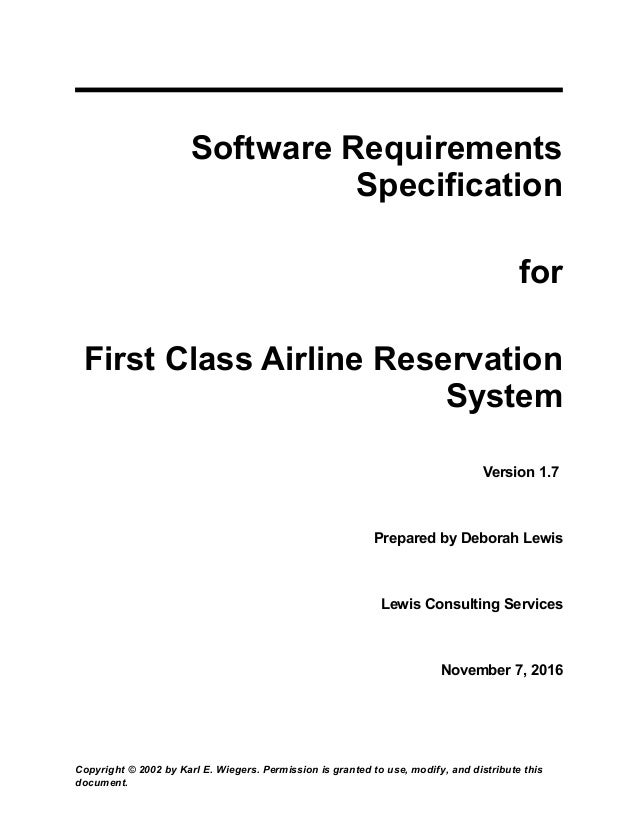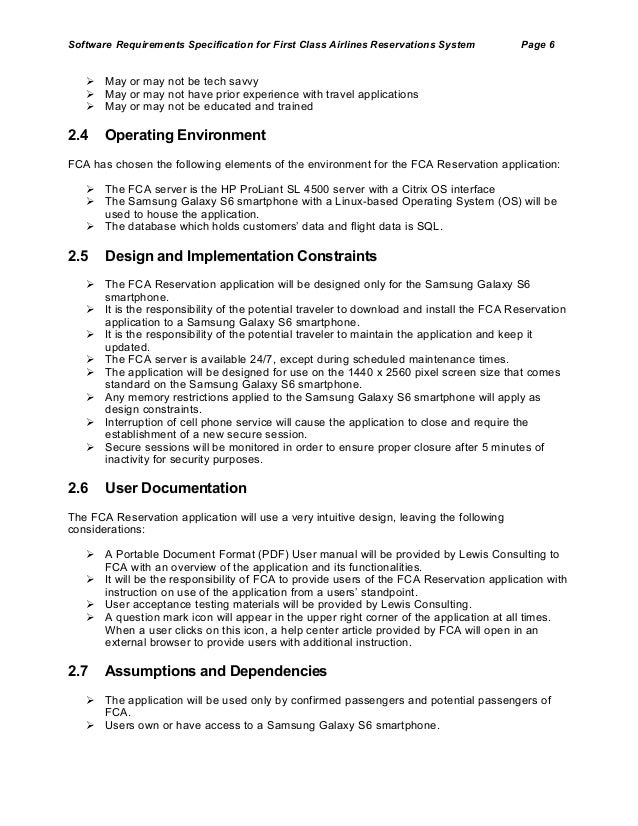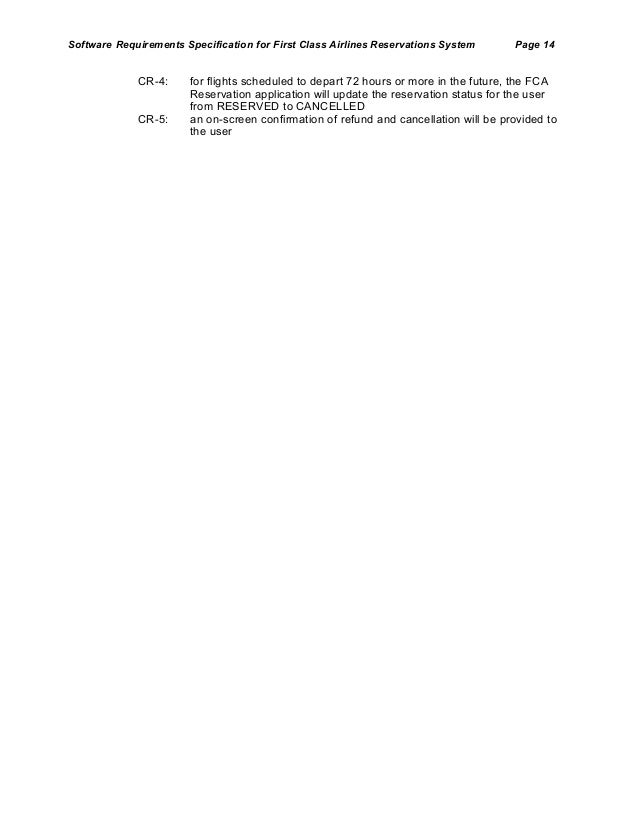Airline Reservation System Software Requirements Specification
1.1 The Airline Reservation System (ARS) is a software application to assist an airline with transactions related to making ticket reservations, which includes blocking, reserving, canceling and rescheduling tickets. This project deals with the development of a Software Requirements Specification (SRS) document that specifies what an airline reservation system.
A Software Requirements Specification (SRS) is a document that describes the nature of a project, software or application. In simple words, SRS document is a manual of a project provided it is prepared before you kick-start a project/application. This document is also known by the names SRS report, software document. A software document is primarily prepared for a project, software or any kind of application.
There are a set of guidelines to be followed while preparing the software requirement specification document. This includes the purpose, scope, functional and nonfunctional requirements, software and hardware requirements of the project. In addition to this, it also contains the information about environmental conditions required, safety and security requirements, software quality attributes of the project etc. What is a Software Requirements Specification document? A Software requirements specification document describes the intended purpose, requirements and nature of a software to be developed. It also includes the yield and cost of the software.

In this document, flight management project is used as an example to explain few points. Table of Contents.
Suggested Read:. 1. INTRODUCTION 1.1 PURPOSE The purpose of this document is to build an online system to manage flights and passengers to ease the flight management.
1.2 DOCUMENT CONVENTIONS This document uses the following conventions. DB Database DDB Distributed Database ER Entity Relationship 1.3 INTENDED AUDIENCE AND READING SUGGESTIONS This project is a prototype for the flight management system and it is restricted within the college premises. This has been implemented under the guidance of college professors.
This project is useful for the flight management team and as well as to the passengers. 1.4 PROJECT SCOPE The purpose of the online flight management system is to ease flight management and to create a convenient and easy-to-use application for passengers, trying to buy airline tickets. The system is based on a relational database with its flight management and reservation functions. We will have a database server supporting hundreds of major cities around the world as well as thousands of flights by various airline companies. Above all, we hope to provide a comfortable user experience along with the best pricing available. 1.5 REFERENCES.
Fundamentals of database systems by ramez elmarsi and shamkant b.navathe 2. OVERALL DESCRIPTION 2.1 PRODUCT PERSPECTIVE A distributed airline database system stores the following information. Flight details: It includes the originating flight terminal and destination terminal, along with the stops in between, the number of seats booked/available seats between two destinations etc. Customer description: It includes customer code, name, address and phone number. This information may be used for keeping the records of the customer for any emergency or for any other kind of information. Reservation description: It includes customer details, code number, flight number, date of booking, date of travel.
2.2 PRODUCT FEATURES The major features of airline database system as shown in below ( ER model). The diagram shows the layout of airline database system – entity–relationship model 2.3 USER CLASS and CHARACTERISTICS Users of the system should be able to retrieve flight information between two given cities with the given date/time of travel from the database. A route from city A to city B is a sequence of connecting flights from A to B such that: a) there are at most two connecting stops, excluding the starting city and destination city of the trip, b) the connecting time is between one to two hours. The system will support two types of user privileges, Customer, and Employee. Customers will have access to customer functions, and the employees will have access to both customer and flight management functions. The customer should be able to do the following functions:. Make a new reservation.
One-way. Round-Trip. Multi-city. Flexible Date/time.
Confirmation. Cancel an existing reservation. View his itinerary The Employee should have following management functionalities:. CUSTOMER FUNCTIONS. Get all customers who have seats reserved on a given flight. Get all flights for a given airport.

View flight schedule. Get all flights whose arrival and departure times are on time/delayed. Calculate total sales for a given flight. ADMINISTRATIVE. Add/Delete a flight. Add a new airport.
Update fare for flights. Add a new flight leg instance.
Update departure/arrival times for flight leg instances. Each flight has a limited number of available seats. There are a number of flights which depart from or arrive at different cities on different dates and time. 2.4 OPERATING ENVIRONMENT Operating environment for the airline management system is as listed below. distributed database.
client/server system. Operating system: Windows. database: sql+ database.
platform: vb.net/Java/PHP 2.5 DESIGN and IMPLEMENTATION CONSTRAINTS. The global schema, fragmentation schema, and allocation schema.
SQL commands for above queries/applications. How the response for application 1 and 2 will be generated. Assuming these are global queries. Explain how various fragments will be combined to do so. Implement the database at least using a centralized database management system.
2.6 ASSUMPTION DEPENDENCIES. Let us assume that this is a distributed airline management system and it is used in the following application:. A request for booking/cancellation of a flight from any source to any destination, giving connected flights in case no direct flight between the specified Source-Destination pair exist. Calculation of high fliers (most frequent fliers) and calculating appropriate reward points for these fliers. Assuming both the transactions are single transactions, we have designed a distributed database that is geographically dispersed at four cities Delhi, Mumbai, Chennai, and Kolkatta as shown in fig.
SYSTEM FEATURES. DESCRIPTION and PRIORITY The airline reservation system maintains information on flights, classes of seats, personal preferences, prices, and bookings. Of course, this project has a high priority because it is very difficult to travel across countries without prior reservations. STIMULUS/RESPONSE SEQUENCES. Search for Airline Flights for two Travel cities.
Displays a detailed list of available flights and make a “Reservation” or Book a ticket on a particular flight. Cancel an existing Reservation. FUNCTIONAL REQUIREMENTS Other system features include: DISTRIBUTED DATABASE: Distributed database implies that a single application should be able to operate transparently on data that is spread across a variety of different databases and connected by a communication network as shown in below figure. Distributed database located in four different cities CLIENT/SERVER SYSTEM The term client/server refers primarily to an architecture or logical division of responsibilities, the client is the application (also known as the front-end), and the server is the DBMS (also known as the back-end). A client/server system is a distributed system in which,. Some sites are client sites and others are server sites.
All the data resides at the server sites. All applications execute at the client sites.
EXTERNAL INTERFACE REQUIREMENTS 4.1 USER INTERFACES. Front-end software: Vb.net version. Back-end software: SQL+ 4.2 HARDWARE INTERFACES. Windows. A browser which supports CGI, HTML & Javascript. 4.3 SOFTWARE INTERFACES Following are the software used for the flight management online application.

Software used Description Operating system We have chosen Windows operating system for its best support and user-friendliness. Database To save the flight records, passengers records we have chosen SQL+ database. VB.Net To implement the project we have chosen Vb.Net language for its more interactive support. 4.4 COMMUNICATION INTERFACES This project supports all types of web browsers.
We are using simple electronic forms for the reservation forms, ticket booking etc. NONFUNCTIONAL REQUIREMENTS 5.1 PERFORMANCE REQUIREMENTS The steps involved to perform the implementation of airline database are as listed below. A) E-R DIAGRAM The E-R Diagram constitutes a technique for representing the logical structure of a database in a pictorial manner. This analysis is then used to organize data as a relation, normalizing relation and finally obtaining a relation database. ENTITIES: Which specify distinct real-world items in an application. PROPERTIES/ATTRIBUTES: Which specify properties of an entity and relationships. RELATIONSHIPS: Which connect entities and represent meaningful dependencies between them.
The diagram shows the ER diagram of airline database B) NORMALIZATION: The basic objective of normalization is to reduce redundancy which means that information is to be stored only once. Storing information several times leads to wastage of storage space and increase in the total size of the data stored.
If a database is not properly designed it can give rise to modification anomalies. Modification anomalies arise when data is added to, changed or deleted from a database table. Similarly, in traditional databases as well as improperly designed relational databases, data redundancy can be a problem. These can be eliminated by normalizing a database. Normalization is the process of breaking down a table into smaller tables.
So that each table deals with a single theme. There are three different kinds of modifications of anomalies and formulated the first, second and third normal forms (3NF) is considered sufficient for most practical purposes. It should be considered only after a thorough analysis and complete understanding of its implications. 5.2 SAFETY REQUIREMENTS If there is extensive damage to a wide portion of the database due to catastrophic failure, such as a disk crash, the recovery method restores a past copy of the database that was backed up to archival storage (typically tape) and reconstructs a more current state by reapplying or redoing the operations of committed transactions from the backed up log, up to the time of failure. 5.3 SECURITY REQUIREMENTS Security systems need database storage just like many other applications. However, the special requirements of the security market mean that vendors must choose their database partner carefully. 5.4 SOFTWARE QUALITY ATTRIBUTES.
AVAILABILITY: The flight should be available on the specified date and specified time as many customers are doing advance reservations. CORRECTNESS: The flight should reach start from correct start terminal and should reach the correct destination. MAINTAINABILITY: The administrators and flight in chargers should maintain correct schedules of flights. USABILITY: The flight schedules should satisfy a maximum number of customers needs.
↓. Post author Hi Muhammad, functional requirements: A functional requirement describes what a software system should do, the way it functions.
Flight starts from one point and reaches the second point. Non-functional requirements: non-functional requirements deals with operations and constraints on how the system will do so. It could be a flight delay, overlap, application hack, latency, efficiency etc.
Non-functional requirements are not straight forward requirement of the system rather it is related to usability. ↓. Post author Hi Kate, This document is application for big projects. For small projects you can cut down few points.
System Requirement Specification Template
You can refer to following contents. Introduction 1.1 Purpose 1.2 Document Conventions 1.3 Intended Audience and Reading Suggestions 1.4 Project Scope 1.5 References 2. Overall Description 2.1 Product Perspective 2.2 Operating Environment 2.3 Design and Implementation Constraints 2.4 Assumptions and Dependencies 3. System Features 4. External Interface Requirements 4.1 User Interfaces 4.2 Hardware Interfaces 4.3 Software Interfaces 5. Other Nonfunctional Requirements 5.1 Performance Requirements 5.2 Safety Requirements 5.3 Security Requirements.
Post author Good question Aarati. Non functional requirements mainly deal with non coding part of the project.
Non functional requirements concentrate on how a application should work rather than what your application should does (functional requirements). So non functional requirements includes performance of the the project, availability of the the project, security, compliance, documentation, deployment etc. An example would be – high level design like overall architectural view of your application. Let me know if you have further questions. ↓.
Post author Hi Dipam, For ER diagram, following types of connectors exist 1. A double line indicates a participation constraint, totality or surjectivity all entities in the entity set must participate in at least one relationship in the relationship set; 2.an arrow from entity set to relationship set indicates a key constraint, i.e. Injectivity: each entity of the entity set can participate in at most one relationship in the relationship set; 3.a thick line indicates both, i.e. Bijectivity: each entity in the entity set is involved in exactly one relationship. 4.an underlined name of an attribute indicates that it is a key: two different entities or relationships with this attribute always have different values for this attribute.
1 A A I 0 1 M u m b a i L o n d o n 0 0. 3 0 2 A A I 0 2 D e l h i P a r i s 0 3. 2 0 3 A A I 0 3 C h e n n a i C o l o m b o 1 9. 3 0 4 A A I 0 4 M u m b a i L o s A n g l e s 0 5. 0 0 5 A A I 0 5 D e l h i D u b a i 0 4.
0 0 The system should get the passengers details such as name, age, address, passport number, which plane he/she wants to travel and the destination point. The software should provide search options. If the source point and destination point are entered, then all the planes traveling between these planes with arrival and de parture time should be displa yed for the sake of passenger. The software should have option for checking availability of the tickets. If the ticket is not available, a short message will appear as “ticket unavailable” will be displayed to the passenger. The software should have facility to cancel the reservation of the ticket and also can modify the changes if the customer has some changes in his reservation ticket.
Airline Reservations Systems
The name of the software is “AIRLINE RESERVATION SYSTEM”. This software provides options for viewing different flights available with dif fer ent tim ing s for a par tic ula r dat e and pro vid es cus tom ers wit h the facility to book a ticket, modify or cancel a particular reservation but it does not provide the customers with details of cost of the ticket and it does not allow the customer to modify a particular part of his reservation and he/she can modify all his details. 1.3 DEFINITIONS, ACRONYMS AND ABBREVIATIONS ARS-Airline Reservation System LAN-Local Area Network GUI-Graphical User Interface OS-Operating System RAM-Random Access Memory MB-Mega Bytes GB-Giga Bytes Mbps-Mega bits per second HDD-Hard Disk Drive.